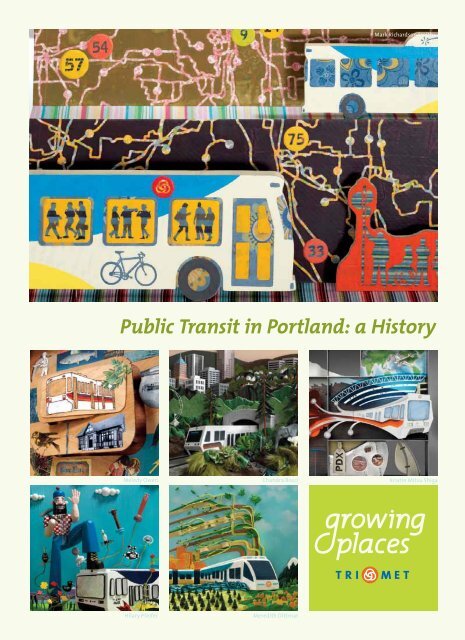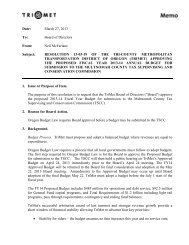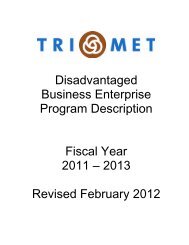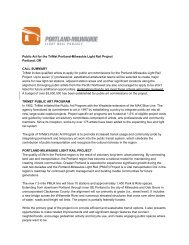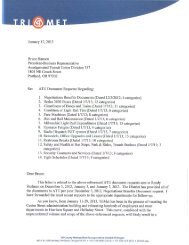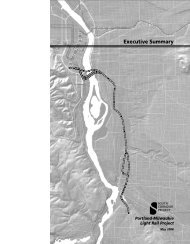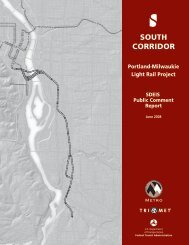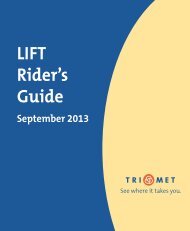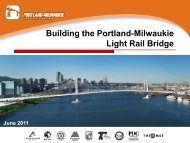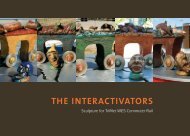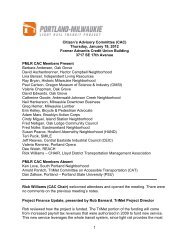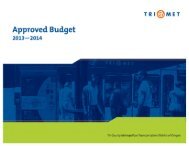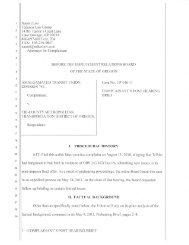Public Transit in Portland: a History - TriMet
Public Transit in Portland: a History - TriMet
Public Transit in Portland: a History - TriMet
Create successful ePaper yourself
Turn your PDF publications into a flip-book with our unique Google optimized e-Paper software.
Mark Richardson Smith<br />
<strong>Public</strong> <strong>Transit</strong> <strong>in</strong> <strong>Portland</strong>: a <strong>History</strong><br />
Melody Owen<br />
Chandra Bocci<br />
Krist<strong>in</strong> Mitsu Shiga<br />
Hilary Pfeifer<br />
Meredith Dittmar
Travel<strong>in</strong>g through time<br />
Dear Reader,<br />
<strong>Transit</strong> plays a critical role <strong>in</strong> provid<strong>in</strong>g options for travel<strong>in</strong>g throughout the region.<br />
It connects people to work, school, recreational dest<strong>in</strong>ations and essential services.<br />
It’s not just a commuter service. It’s a community asset. And the benefits extend far<br />
beyond those who ride.<br />
<strong>TriMet</strong>’s transit system is recognized as a national leader for its connection to<br />
land use. By l<strong>in</strong>k<strong>in</strong>g land-use plann<strong>in</strong>g and transit, we have helped create livable<br />
communities, vibrant neighborhoods and provide alternatives to driv<strong>in</strong>g.<br />
<strong>Transit</strong> is also a catalyst for economic development. More than $10 billion <strong>in</strong><br />
transit-oriented development has occurred with<strong>in</strong> walk<strong>in</strong>g distance of MAX light rail<br />
stations s<strong>in</strong>ce the decision to build <strong>in</strong> 1980. Developers like the<br />
permanence of rail when <strong>in</strong>vest<strong>in</strong>g <strong>in</strong> projects.<br />
<strong>Transit</strong> is also valued by the community. Most of our riders—81<br />
percent—are choice riders. They have a car available or choose<br />
not to own one so they can ride <strong>TriMet</strong>. With more than 315,000<br />
trips taken each weekday on our buses, MAX Light Rail and WES<br />
Commuter Rail, we elim<strong>in</strong>ate 65 million annual car trips. That<br />
eases traffic congestion and helps keep our air clean. <strong>TriMet</strong><br />
carries more people than any other U.S. transit system our size.<br />
Our many <strong>in</strong>novations have drawn the attention of government<br />
leaders, planners, transit providers and transit users from around<br />
the world.<br />
We didn’t start out that way. When <strong>TriMet</strong> was created <strong>in</strong> 1969,<br />
the former transit agency was fac<strong>in</strong>g bankruptcy, with dw<strong>in</strong>dl<strong>in</strong>g<br />
ridership and little community support. Over the years, we’ve<br />
built partnerships with government agencies, key stakeholders,<br />
bus<strong>in</strong>esses and the public. This region has come together and created a shared<br />
vision that ensures transit cont<strong>in</strong>ues to play a lead<strong>in</strong>g role <strong>in</strong> this region’s livability<br />
and growth.<br />
As you look through this publication, you’ll see the events that have formed the<br />
history of public transportation <strong>in</strong> the <strong>Portland</strong> area. You’ll also see how far we’ve<br />
come from our early days of horse-drawn streetcars to today with 79 bus l<strong>in</strong>es, a<br />
52-mile light rail network and the state’s first commuter rail l<strong>in</strong>e, and where we’re<br />
headed next.<br />
Neil McFarlane<br />
General Manager<br />
<strong>TriMet</strong>
<strong>Portland</strong>’s first<br />
transit system<br />
Twenty-one years after <strong>Portland</strong> is<br />
officially founded, the city’s growth<br />
prompts the need for a public<br />
transportation system. A horsedrawn<br />
streetcar l<strong>in</strong>e opens, runn<strong>in</strong>g<br />
along SW 1st Avenue.<br />
Electric streetcars beg<strong>in</strong><br />
service, gradually replac<strong>in</strong>g<br />
horse-drawn, cable and<br />
steam-powered l<strong>in</strong>es. Installed<br />
by land developers to promote<br />
new subdivisions, a network<br />
eventually extends out to city<br />
limits <strong>in</strong> all directions.<br />
Interurban railway service<br />
now extends from Vancouver<br />
south to Eugene and Corvallis,<br />
and from Gresham and<br />
Troutdale west to Forest Grove<br />
and McM<strong>in</strong>nville.<br />
Meanwhile, the “Good<br />
Roads” movement takes<br />
shape: Oregon embraces the<br />
automobile and becomes the<br />
first state to pay for roads<br />
with a gas tax.<br />
1872<br />
1888<br />
1889<br />
1893<br />
1910<br />
1920s<br />
Steam-operated streetcar<br />
l<strong>in</strong>es beg<strong>in</strong> service, develop<strong>in</strong>g<br />
<strong>in</strong>to a network that serves<br />
Hawthorne, Mt. Scott, Mt.<br />
Tabor, St. Johns, west <strong>Portland</strong>,<br />
and Vancouver, Wash<strong>in</strong>gton.<br />
Rail transit riders<br />
with new residen<br />
suburbs spr<strong>in</strong>g<strong>in</strong><br />
the rail l<strong>in</strong>es, mak<br />
the center of one<br />
urban rail system<br />
A 16-mile <strong>in</strong>terurban electric<br />
railway and high-voltage<br />
transmission l<strong>in</strong>e are<br />
constructed from Willamette<br />
Falls <strong>in</strong> Oregon City to<br />
<strong>Portland</strong>–one of the first<br />
attempts at long-distance<br />
electrical transmission,<br />
and one of the nation’s first<br />
<strong>in</strong>terurban electric railways.<br />
Other <strong>in</strong>terurban l<strong>in</strong>es follow,<br />
connect<strong>in</strong>g <strong>Portland</strong> to its<br />
suburbs and outly<strong>in</strong>g towns.<br />
200<br />
150<br />
100<br />
100<br />
50<br />
70<br />
0<br />
1910 1920
Several <strong>in</strong>terurban rail l<strong>in</strong>es<br />
discont<strong>in</strong>ue passenger service<br />
as ridership decl<strong>in</strong>es. The<br />
ag<strong>in</strong>g streetcar system beg<strong>in</strong>s<br />
convert<strong>in</strong>g to buses and<br />
trolleybuses. In time, <strong>Portland</strong><br />
enjoys an extensive trolleybus<br />
network, particularly on the<br />
east side.<br />
The last streetcar runs as ridership<br />
drops sharply after the war. As<br />
the <strong>Portland</strong> region cont<strong>in</strong>ues to<br />
grow, the new suburbs beyond<br />
the old transit network become<br />
<strong>in</strong>creas<strong>in</strong>gly dependent on<br />
automobiles, and traffic congestion<br />
soon becomes a concern.<br />
The Columbia Region<br />
Association of Governments<br />
(CRAG), a new regional<br />
plann<strong>in</strong>g agency, is set up<br />
to coord<strong>in</strong>ate the <strong>Portland</strong>-<br />
Vancouver Metropolitan<br />
Area Transportation Study<br />
(PVMATS). It provides the first<br />
comprehensive analysis of<br />
travel demand <strong>in</strong> the region,<br />
assum<strong>in</strong>g no constra<strong>in</strong>ts on<br />
highway travel.<br />
1930s<br />
1944<br />
1950<br />
1958<br />
1959<br />
hip peaks,<br />
tial areas and<br />
g up along<br />
<strong>in</strong>g <strong>Portland</strong><br />
of the largest<br />
s <strong>in</strong> the West.<br />
<strong>Portland</strong>-area transit ridership<br />
peaks at an all-time high<br />
dur<strong>in</strong>g World War II, due <strong>in</strong><br />
part to limited availability of<br />
automobiles and <strong>Portland</strong>’s<br />
extensive transit <strong>in</strong>frastructure.<br />
The pioneer <strong>in</strong>terurban<br />
electric rail l<strong>in</strong>e to Oregon<br />
City and the trolleybuses<br />
die out as ridership decl<strong>in</strong>es<br />
to less than a fifth of its<br />
wartime level. The transit<br />
system now consists of gas<br />
buses operated by seven<br />
different bus companies.<br />
160<br />
60<br />
<strong>Transit</strong> Ridership <strong>in</strong> the <strong>Portland</strong> Region<br />
(<strong>in</strong> millions)<br />
28<br />
15 20<br />
35<br />
48<br />
69<br />
85<br />
94<br />
105<br />
1944 1950 1958 1971 1973 1978 1985 1986 1998 2004 2010
The <strong>Portland</strong>-Vancouver Metropolitan<br />
Area Transportation Study (PVMATS)<br />
results <strong>in</strong> a “Transportation Plan for<br />
1990” that recommends 54 major new<br />
highway projects, many of them freeways<br />
and expressways. It predicts the decl<strong>in</strong><strong>in</strong>g<br />
bus system will rema<strong>in</strong> <strong>in</strong>significant as<br />
a transportation source except for the<br />
rush-hour commute to downtown. The<br />
Oregon Legislature adopts Senate Bill<br />
100 establish<strong>in</strong>g land-use laws to protect<br />
livability and prevent sprawl.<br />
The newly passed Federal Aid<br />
Highway Act allows states to<br />
transfer funds from segments<br />
of the Interstate system<br />
no longer required to fund<br />
alternative road or transit<br />
projects. Shortly after, local<br />
jurisdictions formally reject<br />
the $400 million Mt. Hood<br />
Freeway project <strong>in</strong> response to<br />
citizen outcry. The region seeks<br />
to transfer some of the funds<br />
to transit projects. The Oregon<br />
<strong>Public</strong> Utility Commission<br />
publishes a report propos<strong>in</strong>g a<br />
regional light rail system based<br />
largely on exist<strong>in</strong>g railroad<br />
right-of-ways.<br />
1969<br />
1971<br />
Early 1973<br />
Late 1973<br />
1974<br />
<strong>Portland</strong>’s transit ridership<br />
cont<strong>in</strong>ues to fall. The Rose<br />
City <strong>Transit</strong> Company, faced<br />
with bankruptcy, demands a<br />
major fare hike, threaten<strong>in</strong>g<br />
to discont<strong>in</strong>ue all service. The<br />
Oregon Legislature passes<br />
House Bill 1808 allow<strong>in</strong>g the<br />
creation of transit districts and<br />
provid<strong>in</strong>g them with the power<br />
to raise revenue through a<br />
payroll tax. The <strong>Portland</strong> region<br />
establishes the Tri-County<br />
Metropolitan Transportation<br />
District of Oregon, called<br />
<strong>TriMet</strong>, to take over the local<br />
bus systems and provide<br />
regional transit service.<br />
<strong>TriMet</strong> is formed<br />
<strong>TriMet</strong> completes an<br />
“immediate action plan”<br />
and a “1990 Master Plan” to<br />
reverse the transit system’s<br />
decl<strong>in</strong>e. It recommends<br />
consolidat<strong>in</strong>g all local<br />
bus service under <strong>TriMet</strong>,<br />
concentrat<strong>in</strong>g downtown<br />
service on transit malls<br />
along 5th and 6th avenues,<br />
build<strong>in</strong>g suburban Park<br />
& Ride lots, develop<strong>in</strong>g<br />
transitways <strong>in</strong> major<br />
corridors and expand<strong>in</strong>g the<br />
number of buses.<br />
200<br />
150<br />
100<br />
50<br />
70<br />
The region sees a<br />
resurgence <strong>in</strong> transit<br />
usage as public<br />
concerns about the<br />
environment mount.<br />
Downtown park<strong>in</strong>g<br />
limits are enforced,<br />
along with new<br />
emissions standards<br />
for automobiles.<br />
100<br />
160<br />
60<br />
0<br />
1910 1920 1944 1950
Melody Owen<br />
Free rides downtown<br />
Fareless Square opens, creat<strong>in</strong>g<br />
a fare-free zone <strong>in</strong> downtown<br />
<strong>Portland</strong> to promote transit rid<strong>in</strong>g<br />
with<strong>in</strong> downtown. It also seeks to<br />
reduce air pollution by elim<strong>in</strong>at<strong>in</strong>g<br />
short auto trips.<br />
Metro adopts the<br />
urban growth<br />
boundary (UGB) to<br />
manage regional<br />
land use and<br />
development.<br />
Banfield Light Rail—named<br />
the Metropolitan Area Express,<br />
or MAX for short—opens on a<br />
15-mile alignment between<br />
the suburb of Gresham and<br />
downtown <strong>Portland</strong>.<br />
1975 1978<br />
1979<br />
1980<br />
1986<br />
28<br />
15 20<br />
35<br />
The downtown <strong>Portland</strong> <strong>Transit</strong> Mall<br />
opens on 5th and 6th avenues. Light rail<br />
is chosen for the Eastside corridor. Voters<br />
replace CRAG with Metro, an elected<br />
regional government with responsibility<br />
to plan for the region’s future.<br />
<strong>Transit</strong> Ridership <strong>in</strong> the <strong>Portland</strong> Region<br />
(<strong>in</strong> millions)<br />
48<br />
69<br />
85<br />
94<br />
105<br />
The Banfield Light Rail project receives<br />
federal approval for construction.<br />
Though used <strong>in</strong> Europe, the only<br />
modern US light rail has just opened <strong>in</strong><br />
San Diego. <strong>Portland</strong> officials decide its<br />
bare bones treatment is not right for<br />
here and beg<strong>in</strong> to develop their own<br />
approach. Metro adopts a new Regional<br />
Transportation Plan to focus growth<br />
with<strong>in</strong> the UGB and around light rail.<br />
MAX built with freeway fund<br />
1958 1971 1973 1978 1985 1986 1998 2004 2010
Westside MAX<br />
construction beg<strong>in</strong>s<br />
with the 3-mile<br />
tw<strong>in</strong> tunnels under<br />
<strong>Portland</strong>’s West Hills.<br />
Metro adopts the<br />
Region 2040 Growth<br />
Concept, focus<strong>in</strong>g<br />
on <strong>in</strong>creased<br />
density along major<br />
transportation and<br />
light rail corridors<br />
to avoid sprawl <strong>in</strong>to<br />
farmlands. Support for<br />
a downtown streetcar<br />
l<strong>in</strong>e grows as close<strong>in</strong><br />
westside <strong>Portland</strong><br />
neighborhoods stra<strong>in</strong><br />
from growth and<br />
urban revival.<br />
1991<br />
1993<br />
1994<br />
1995<br />
1998<br />
<strong>Portland</strong>’s “V<strong>in</strong>tage Trolley”<br />
re<strong>in</strong>troduces streetcar<br />
service to <strong>Portland</strong> with<br />
work<strong>in</strong>g replicas of the<br />
Council Crest cars runn<strong>in</strong>g<br />
on exist<strong>in</strong>g MAX tracks,<br />
largely as an historic<br />
attraction for visitors.<br />
Streetcars return (almost)<br />
The downtown<br />
<strong>Transit</strong> Mall is<br />
expanded north<br />
of Burnside to<br />
Union Station,<br />
open<strong>in</strong>g up access<br />
to Ch<strong>in</strong>atown, the<br />
Greyhound Bus<br />
station and the<br />
Amtrak station,<br />
while advanc<strong>in</strong>g<br />
development <strong>in</strong><br />
the area.<br />
An 18-mile light rail<br />
extension opens from<br />
downtown <strong>Portland</strong><br />
through the western suburb<br />
of Beaverton to Hillsboro,<br />
serv<strong>in</strong>g the fast-grow<strong>in</strong>g<br />
high-tech corridor <strong>in</strong><br />
Wash<strong>in</strong>gton County. The<br />
Westside MAX extension<br />
connects with the eastside<br />
l<strong>in</strong>e <strong>in</strong> downtown, creat<strong>in</strong>g<br />
a s<strong>in</strong>gle 33-mile alignment<br />
that will eventually be<br />
called the MAX Blue L<strong>in</strong>e.<br />
Four Frequent Service bus<br />
l<strong>in</strong>es are established, with<br />
service every 15 m<strong>in</strong>utes or<br />
better every day.<br />
An Oregon-only light rail<br />
project to replace the<br />
orig<strong>in</strong>al South-North<br />
extension proposal fails <strong>in</strong><br />
the region, but is supported<br />
with<strong>in</strong> Multnomah County<br />
and the city of <strong>Portland</strong>.<br />
Chandra Bocci
Airport, modern streetcar l<strong>in</strong>es built<br />
Airport MAX Red<br />
L<strong>in</strong>e construction<br />
beg<strong>in</strong>s, as does<br />
construction of the<br />
<strong>Portland</strong> Streetcar.<br />
Modern streetcars<br />
return to North<br />
America with the<br />
open<strong>in</strong>g of the<br />
<strong>Portland</strong> Streetcar.<br />
<strong>TriMet</strong> adopts a new,<br />
up-to-date look, the first<br />
change <strong>in</strong> over 20 years.<br />
The hyphen <strong>in</strong> the name<br />
is dropped, a new color<br />
palette is selected and<br />
all vehicles will boast the<br />
new look.<br />
1999<br />
2000<br />
July 2001<br />
Sept. 2001<br />
Spr<strong>in</strong>g 2002<br />
Service beg<strong>in</strong>s on Airport MAX Red L<strong>in</strong>e, the<br />
first tra<strong>in</strong>-to-plane service on the West Coast.<br />
Fareless Square is extended to the Lloyd District,<br />
across the Willamette River from downtown.<br />
Construction beg<strong>in</strong>s on<br />
Interstate MAX Yellow L<strong>in</strong>e,<br />
which will serve north and<br />
northeast <strong>Portland</strong>. Studies<br />
beg<strong>in</strong> on a possible commuter<br />
rail l<strong>in</strong>e <strong>in</strong> Wash<strong>in</strong>gton County.<br />
200<br />
Krist<strong>in</strong> Mitsu Shiga<br />
150<br />
100<br />
50<br />
70<br />
100<br />
160<br />
60<br />
<strong>Transit</strong> Ridership <strong>in</strong> the <strong>Portland</strong> Region<br />
(<strong>in</strong> millions)<br />
28<br />
15 20<br />
35<br />
48<br />
69<br />
85<br />
94<br />
105<br />
0<br />
1910 1920 1944 1950 1958 1971 1973 1978 1985 1986 1998 2004 2010
Hilary Pfeifer<br />
Twelve more bus l<strong>in</strong>es are<br />
upgraded to Frequent Service,<br />
br<strong>in</strong>g<strong>in</strong>g the total to 16. Riders<br />
flock to these comfortable buses<br />
with 15-m<strong>in</strong>ute service, prov<strong>in</strong>g<br />
that add<strong>in</strong>g frequency and<br />
amenities to exist<strong>in</strong>g routes is<br />
more effective at attract<strong>in</strong>g riders<br />
than offer<strong>in</strong>g new, <strong>in</strong>frequent<br />
routes.<br />
Mark Richardson Smith<br />
Interstate MAX Yellow L<strong>in</strong>e<br />
opens its 5.8-mile extension<br />
from the Rose Quarter <strong>Transit</strong><br />
Center to the Expo Center<br />
ahead of schedule and millions<br />
under budget.<br />
<strong>Portland</strong> Streetcar<br />
passenger service<br />
is extended from<br />
<strong>Portland</strong> State<br />
University to SW<br />
Moody and Gibbs <strong>in</strong><br />
the South Waterfront<br />
District, where it<br />
connects with the<br />
<strong>Portland</strong> Aerial Tram.<br />
The Streetcar l<strong>in</strong>e is<br />
six miles total, with<br />
40 platform stops.<br />
Fall 2002<br />
2003<br />
May 2004<br />
2005<br />
Oct. 2006<br />
In March, <strong>Portland</strong><br />
Streetcar was<br />
extended 0.6 miles<br />
to RiverPlace. In<br />
October, it was<br />
extended 0.6 miles<br />
to Gibbs.<br />
Metro and local governments<br />
approve the South<br />
Corridor Project, outl<strong>in</strong><strong>in</strong>g<br />
transportation options for<br />
Clackamas County. Phase 1<br />
<strong>in</strong>cludes an 8.3-mile light rail<br />
project from Gateway <strong>Transit</strong><br />
Center to Clackamas Town<br />
Center and along the <strong>Portland</strong><br />
Mall between Union Station<br />
and PSU. Phase 2 <strong>in</strong>cludes a<br />
proposed 6-mile extension<br />
from downtown <strong>Portland</strong> to<br />
Milwaukie. <strong>TriMet</strong> develops<br />
a <strong>Transit</strong> Investment Plan<br />
(TIP), a roll<strong>in</strong>g five-year guide<br />
for direct<strong>in</strong>g transit and<br />
transportation <strong>in</strong>vestment <strong>in</strong><br />
the region.<br />
200<br />
150<br />
100<br />
50<br />
70<br />
100<br />
160<br />
60<br />
<strong>Transit</strong><br />
28<br />
15<br />
0<br />
1910 1920 1944 1950 1958 1971
The 14.7-mile WES (Westside Express Service) Commuter Rail l<strong>in</strong>e<br />
opened us<strong>in</strong>g exist<strong>in</strong>g freight tracks. WES is the first suburb-tosuburb<br />
commuter rail l<strong>in</strong>es <strong>in</strong> the nation. It provides weekday<br />
rush hour service between Beaverton, Tigard, Tualat<strong>in</strong> and<br />
Wilsonville, connects to MAX Light Rail <strong>in</strong> Beaverton and adds<br />
a welcome alternative to I-5/Highway 217 for commuters <strong>in</strong><br />
Wash<strong>in</strong>gton and Clackamas counties.<br />
Aug. 2007<br />
Feb. 2009 Aug. 2009<br />
Sept. 2009<br />
<strong>Portland</strong> Streetcar is extended 0.4<br />
miles to Lowell; the South Waterfront<br />
District. This extension lengthens the<br />
Streetcar l<strong>in</strong>e to eight miles total with<br />
46 platform stops.<br />
Construction<br />
began on the<br />
<strong>Portland</strong> Streetcar<br />
Loop Project.<br />
The Loop is a 3.3<br />
mile extension<br />
of the Streetcar<br />
l<strong>in</strong>e connect<strong>in</strong>g<br />
Downtown<br />
<strong>Portland</strong> to the<br />
Eastside and<br />
south to OMSI.<br />
Meredith Dittmar<br />
Ridership <strong>in</strong> the <strong>Portland</strong> Region<br />
(<strong>in</strong> millions)<br />
20<br />
35<br />
48<br />
69<br />
85<br />
94<br />
105<br />
<strong>TriMet</strong>’s fifth MAX l<strong>in</strong>e, the<br />
8.2 mile Green L<strong>in</strong>e opens,<br />
connect<strong>in</strong>g Clackamas County<br />
to downtown <strong>Portland</strong>. It is the<br />
first light rail extension <strong>in</strong>to<br />
Clackamas County and achieves<br />
the major milestone of light rail<br />
connect<strong>in</strong>g all three counties <strong>in</strong><br />
<strong>TriMet</strong>’s region. The MAX system<br />
is now a 52-mile system with 84<br />
stations.<br />
1973 1978 1985 1986 1998 2004 2010
Future plans for public<br />
transit <strong>in</strong> <strong>Portland</strong><br />
and the surround<strong>in</strong>g<br />
communities<br />
The <strong>Portland</strong>-Milwaukie Light Rail<br />
Project will create a 7.3-mile light<br />
rail l<strong>in</strong>e connect<strong>in</strong>g <strong>Portland</strong> and<br />
Milwaukie. Construction is expected<br />
to beg<strong>in</strong> <strong>in</strong> 2011, with the l<strong>in</strong>e<br />
open<strong>in</strong>g <strong>in</strong> 2015.<br />
The <strong>Portland</strong> Streetcar Loop Project Is<br />
currently under construction, and will<br />
extend service from the Pearl District<br />
<strong>in</strong> NW <strong>Portland</strong>, across the Broadway<br />
Bridge to the Lloyd Center area and<br />
south through the Central Industrial<br />
Eastside to the Oregon Museum<br />
of Science and Industry. Service is<br />
scheduled to beg<strong>in</strong> <strong>in</strong> 2012.<br />
The Columbia River Cross<strong>in</strong>g is<br />
a bridge, transit and highway<br />
improvement project connect<strong>in</strong>g<br />
Vancouver, Wash<strong>in</strong>gton and <strong>Portland</strong>,<br />
Oregon. A new I-5 bridge will <strong>in</strong>clude<br />
a light rail l<strong>in</strong>e to Clark College <strong>in</strong><br />
Vancouver. Once construction beg<strong>in</strong>s,<br />
it is expected to last five to seven<br />
years.<br />
The Lake Oswego-<strong>Portland</strong> <strong>Transit</strong><br />
Project is explor<strong>in</strong>g options for<br />
improv<strong>in</strong>g travel between Lake<br />
Oswego and <strong>Portland</strong>, possibly by<br />
extend<strong>in</strong>g the <strong>Portland</strong> Streetcar<br />
along the Willamette Shore L<strong>in</strong>e right<br />
of way, a former freight rail route<br />
between Lake Oswego and <strong>Portland</strong><br />
that runs along the Willamette River.<br />
Available <strong>in</strong> other formats.<br />
091000 • 10/10 • 2M


